COVID-19 Wales situational report: 29 July 2021
Update from the COVID-19 Intelligence Cell and Health Protection Advisory Group.
This file may not be fully accessible.
In this page
COVID-19 situation report summary
Key points to note
Wales is at Alert Level 1 as of 24 July. On 7 August Wales is planned to move to Alert Level 0.
Overall transmission of COVID-19 has decreased across Wales, although the percentage of people testing positive has remained steady. The JBC consensus estimate of the reproduction number for Wales is between 1.0 and 1.3, while PHW's estimate is around 0.8. Source: JBC/ PHW (28/7/21). Note that JBC's estimate is typically lagged by 2-3 weeks while PHW, which uses a different methodology, is lagged by around 1 week. Slide 3, Source: PHW
Covid-19 related pressure on the NHS has been steadily increasing over recent weeks. As at 28 July 2021, there were 192 COVID-19 related patients (Suspected, Confirmed and Recovering) occupying a hospital bed, an increase of 16 from the previous week. There are 19 patients with Suspected or Confirmed COVID-19 in critical care beds in Wales. The total number of patients in critical care for both COVID-19 and non-COVID-19 is 155, 3 more than the pre-pandemic maximum critical care capacity of approximately 152.
As at 27 July 2021, Wales has 9,465 confirmed cases of the dominant Delta variant (an increase of 1,648 from the previous week). One new case of Alpha was detected this week. No other variants of concern were detected. Of the 9,465 cases detected to date, 46% of cases were in unvaccinated individuals, 30% received 1 dose and 24% had received 2 doses. Note that this data may include vaccinations that have not yet been given the 14 – 21 days necessary to provide maximum protection against COVID-19. Of the 9,465 cases, 129, or 1.4%, were hospitalised. Source: PHW
On vaccination, as at 28 July 2021, a total of 4.33 (+0.09) million doses of COVID-19 vaccine have been given in Wales, of which 2.29 (+0.01) million were first doses and 2.04 million (+0.08) were second doses, meaning that 80% of people aged 18 and over are now fully vaccinated. Based on SAGE's estimate of an immunity coverage requirement of at least 80% for the delta variant (including under 18s), current coverage will not offer population level protection in the absence of other protective behaviours. Source: PHW, SPI-M-O
Key indicators
Several key indicators are showing an increase, following a period of low transmission in April and May. The cases are starting to decrease.
Please note that the arrows represent a change in comparison for the last week.
| Current value (24/07/21) | Change since previous week (17/07/21 – 24/07/21 unless stated otherwise) | ||||
|---|---|---|---|---|---|
| Percentage change | Value change | ||||
| Confirmed case rate (rolling 7 day sum per 100k) | 154 | -19% | ↓ | (-35) | |
| Confirmed case rate for over 60s (rolling 7 day sum per 100k) | 57 | 4% | ↑ | (+2) | |
| Test positivity (7 day RA) | 10.80% | 2% | - | (+0.2 percentage points) | |
| Population estimated to have COVID-19 (prevalence)1 | 0.62% | 32% | ↑ | (+0.15 percentage points) | |
| NHS COVID-19 Admissions2 | 16 | 19% | ↑ | (+3) | |
| ONS deaths (7 day sum)3 | 10 | 400% | ↑ | (+8) | |
| PHW deaths (7 day sum) | 12 | 33% | ↑ | (+3) | |
- Latest COVID Infection Survey data is taken from 18 July 2021 to 24 July 2021.
- Seven day rolling average to the current date of confirmed COVID-19 patients – does not include COVID-19 suspected or recovering.
- Latest ONS deaths data is to 16 July 2021 (rather than 24 July 2021) for the current value. Data to 9 July 2021 is used for the change since previous week.
What is the current status of the epidemic?
| Local Authority | Health Board | Number | % of All Wales Total | Case Incidence per 100,000 | Change from previous week |
|---|---|---|---|---|---|
| Denbighshire | BCUHB | 405 | 8.2% | 423.2 | -14% ↓ |
| Conwy | BCUHB | 373 | 7.5% | 318.3 | -10% ↓ |
| Wrexham | BCUHB | 353 | 7.1% | 259.6 | -20% ↓ |
| Flintshire | BCUHB | 383 | 7.7% | 245.4 | -16% ↓ |
| Bridgend | CTMUHB | 302 | 6.1% | 205.4 | -26% ↓ |
| Powys | PTHB | 231 | 4.7% | 174.4 | -28% ↓ |
| Merthyr Tydfil | CTMUHB | 93 | 1.9% | 154.2 | 9% ↑ |
| Rhondda Cynon Taf | CTMUHB | 359 | 7.3% | 148.8 | -12% ↓ |
| Cardiff | CVUHB | 542 | 11.0% | 147.7 | -23% ↓ |
| Newport | ABUHB | 219 | 4.4% | 141.6 | -14% ↓ |
| Torfaen | ABUHB | 130 | 2.6% | 138.4 | -38% ↓ |
| Monmouthshire | ABUHB | 123 | 2.5% | 130 | -29% ↓ |
| Swansea | SBUHB | 301 | 6.1% | 121.9 | -9% ↓ |
| Vale of Glamorgan | CVUHB | 151 | 3.1% | 113 | -30% ↓ |
| Ceredigion | HDUHB | 82 | 1.7% | 112.8 | 4% ↑ |
| Caerphilly | ABUHB | 196 | 4.0% | 108.2 | -9% ↓ |
| Neath Port Talbot | SBUHB | 142 | 2.9% | 99.1 | -1% ↓ |
| Isle of Anglesey | BCUHB | 69 | 1.4% | 98.5 | -16% ↓ |
| Pembrokeshire | HDUHB | 121 | 2.4% | 96.2 | -10% ↓ |
| Gwynedd | BCUHB | 117 | 2.4% | 93.9 | -23% ↓ |
| Blaenau Gwent | ABUHB | 63 | 1.3% | 90.2 | -23% ↓ |
| Carmarthenshire | HDUHB | 147 | 3.0% | 77.9 | -17% ↓ |
| Unknown | Unknown | 46 | 0.9% | - | -2% ↓ |
| Total | Total | 4948 | 100.0% | 156.9 | -18% ↓ |
At a Wales level, on 23 July 2021, the 7-day rolling incidence of COVID-19 cases has decreased since last week. The percentage of people testing positive for COVID-19 has remained steady since last week (slide 2).
The JBC consensus estimate of Reproduction number (Rt) is between 1.0 and 1.3 (as at 28 July 2021), with a doubling time of 18 days to flat. When we look at reproduction numbers using PHW positive test data only (see second table below) - a more timely estimate but limited by variation in testing - we see an Rt of 0.8 for Wales and a national halving time of 67 days. When R is below 1.0, the pandemic is shrinking. Rt is highest for Swansea Bay health board at 1.0. PHW central estimates of halving times at health board level range from 31 to 79 days. Source: SAGE/ PHW
7-day cumulative case incidence in Wales has decreased by a fifth in the last week. Case incidence has fell to 156.9 per 100,000 population in Wales compared with 190.1 per 100,000 population last week.
Case incidence is decreasing in almost all local authorities. Case incidence is above 100 per 100,000 population for 16 of the 22 local authorities. Local authorities with the highest case incidences are Denbighshire and Conwy at 423.2 and 318.3 per 100,000 population, respectively, although case incidence is decreasing in these areas. Case incidence is increasing for Merthyr Tydfil and Ceredigion.
Case incidence is highest in those aged 10-19 and 20-29. Case incidence has decreased throughout the week in these age groups. Case incidence is highest for the Betsi Cadwaladr health board. Case incidence is stable or decreasing in all health boards.
The table below provides estimates of doubling and halving times based on PHW COVID-19 positive test data. In this table, doubling times are positive, whilst halving times are negative. The 95% confidence intervals are showing in brackets after the central estimate. An asterisk (*) means that there are small numbers and estimates should be treated with caution. Local health board level estimates of Rt and halving times will be unstable when incidence is low.
| Local HealthBoard | Rt (cases) | Halving time (days) | |
|---|---|---|---|
| All Wales | 0.8 (0.8 to 0.8) | 67 (16 to -32) | |
| Swansea Bay UHB | 1.0 (0.9 to 1.0) | 41 (14 to –39) DOUBLING | |
| CTM UHB | 0.9 (0.8 to 0.9) | 58 (15 to -32) | |
| Aneurin BevanUHB | 0.8 (0.8 to 0.9) | 31 (15 to -188) | |
| Cardiff & ValeUHB | 0.8 (0.7 to 0.8) | 38 (14 to -55) | |
| HywelDda UHB* | 0.9 * (0.8 to 1.0) | 31* (10 to -29) DOUBLING | |
| Powys THB* | 0.8 * (0.7 to 0.9) | 36* (11 to -28) | |
| Betsi CadwaladrUHB | 0.9 (0.8 to 0.9) | 79 (19 to -36) | |
Cases per 100k (PHW Data) (7 day rolling sum)

Cases per 100k by age (PHW Data) (7 day rolling sum)

Data as at 12:00PM 28 July 2021 unless otherwise specified.
What is the situation with the NHS and social care?
COVID-19 pressure on the NHS has been steadily increasing over recent weeks. As at 28 July 2021, there were 192 COVID-19 related patients (Suspected, Confirmed and Recovering) occupying a hospital bed. This compares to 176 (16 more occupied beds) on 21 July 2021. Confirmed patients accounted for 139 of the total occupied beds, and are at similar levels to late March 2021.
There are 19 patients with Suspected or Confirmed COVID-19 in critical care beds in Wales. This is 145 lower than the maximum COVID-19 position of approximately 164. The total number of patients in critical care for both COVID-19 and non-COVID-19 stands at 155, 3 more than the historic maximum critical care capacity of approximately 152.
In the latest National Situation Background Assessment Recommendation (SBAR) report covering the week of 19 July 2021 to 25 July 2021, IMTs reported 91 care homes were in 'red' status (an ongoing outbreak/incident reported within the last 7 days), with 2 health boards reporting having no care homes in 'red' status. This is compared with 69 care homes in 'red' status in the 7 days up to 18 July 2021. Source: National SBAR
Confirmed hospital occupancy (7 day rolling average)
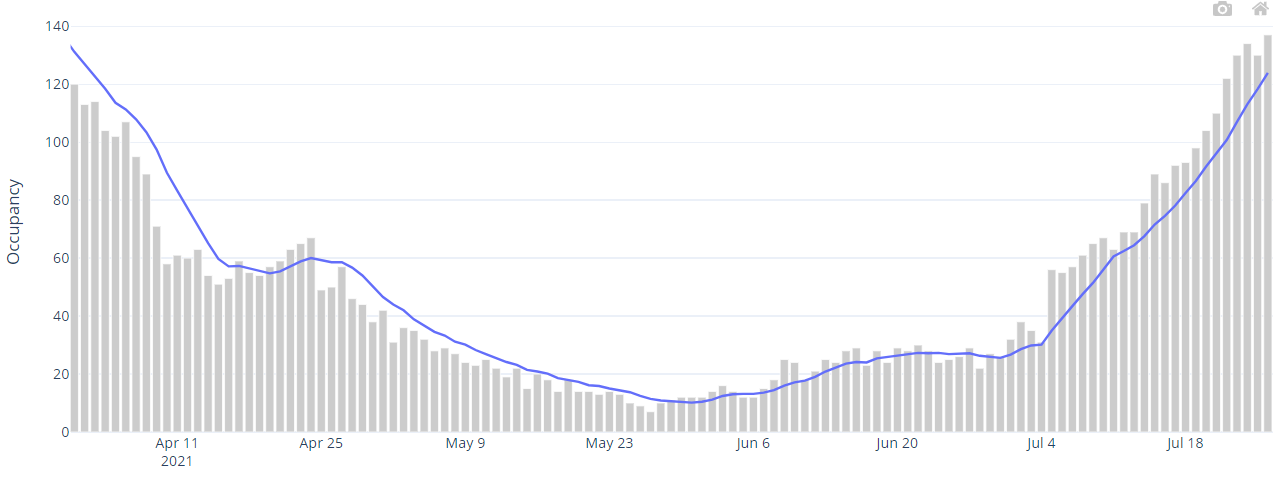
Overall invasive ventilated bed occupancy (7 day rolling average)
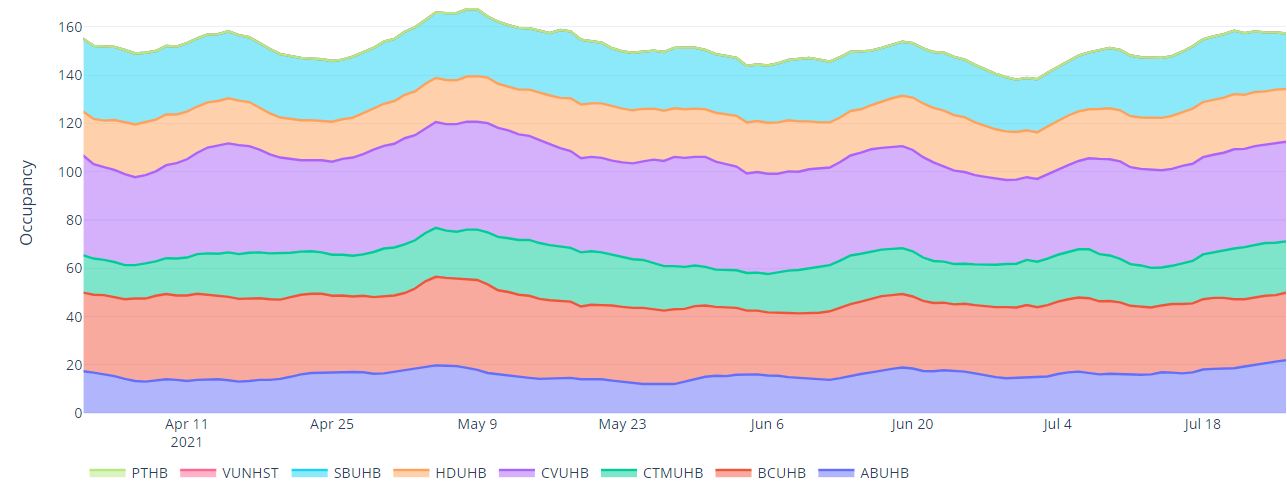
Hospital bed occupancy for suspected and confirmed COVID-19 positive patients (7 day rolling average)
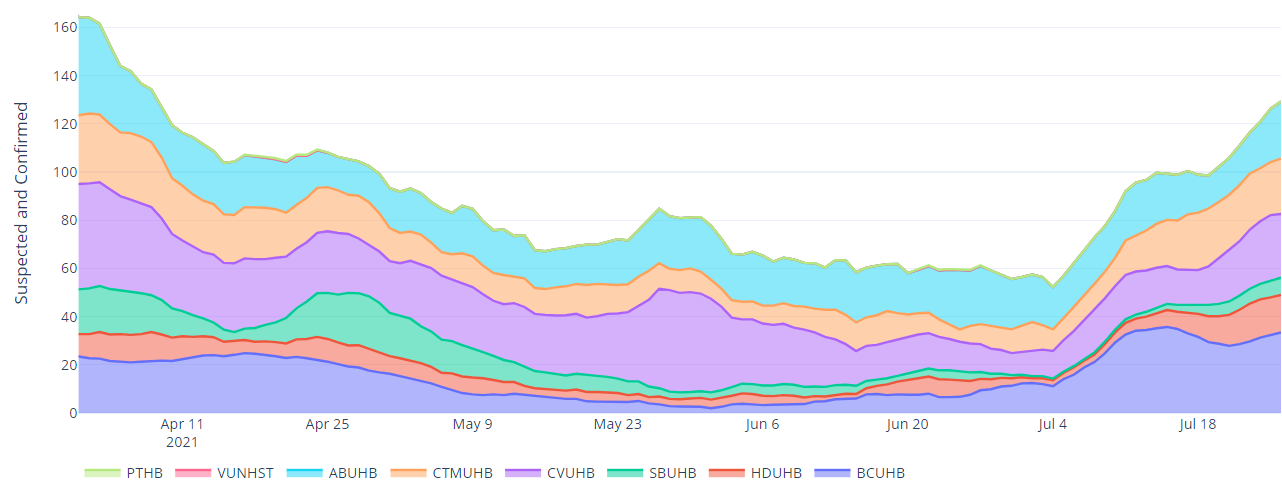
Invasive ventilated bed occupancy for suspected and confirmed COVID-19 positive patients (7 day rolling average)
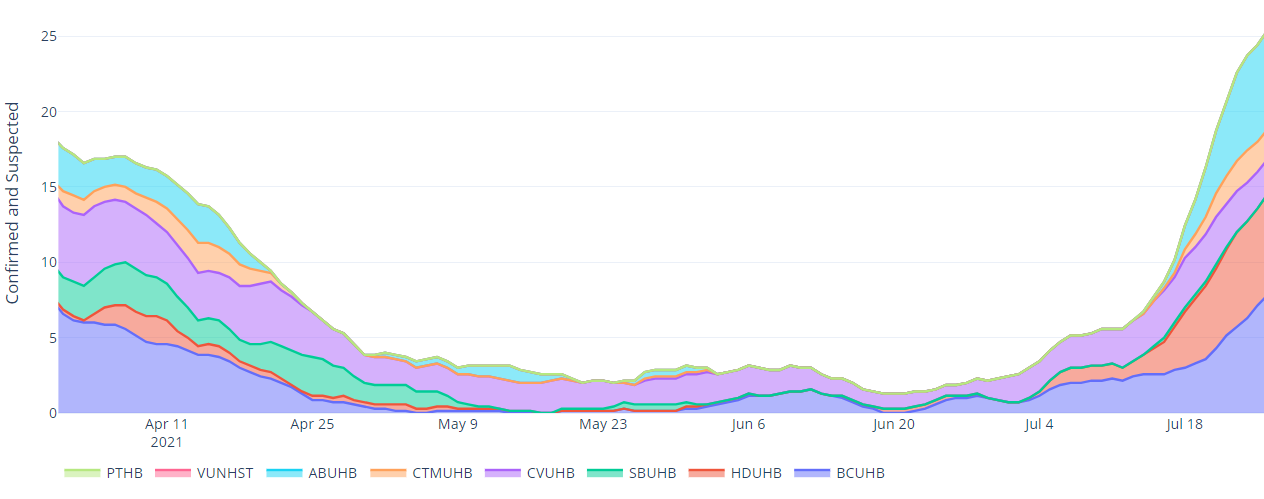
Number of adult care homes reported an ongoing outbreak/incident (last 7 days)
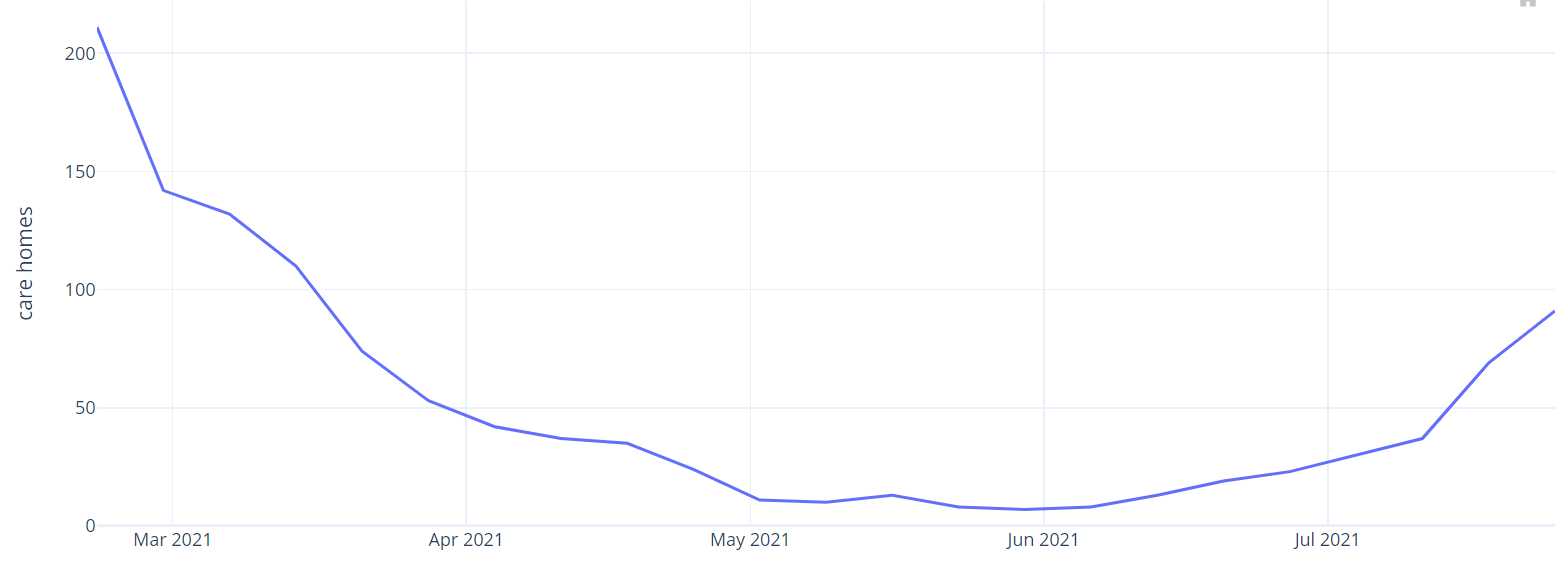
What is the situation with education, children and young adults?
Childcare settings
The latest National Situation Background Assessment Recommendation (SBAR) report covering the week of 19 July to 25 July reported 6* new clusters in childcare settings last week across 5 health boards, compared to 2 new clusters reported the previous week.
Schools
The number of new and on-going school clusters overall has reduced significantly since last week, though a significant number of schools broke up for the Summer term that week so this would have an impact on the reduction. There were 34* new and 69* ongoing clusters associated with schools reported by IMTs last week.
49* are attributed to school settings and 26* to household, social or extra-curricular activities. Source: National SBAR
*Figures do not include Wrexham, Gwynedd or Cardiff & Vale data
School Attendance
The 2020/21 academic year ended on 20 July 2021. The majority of schools had no pupils present on 19 to 20 July due to INSET days. Therefore, this headline presents data up to 16 July only. The figures for the latest two weeks have been revised. An average of 77% of all pupils were present in school over the week of 12 July to 16 July. Source: Stats Wales
Absence due to Covid
An average of 6% of all primary age pupils and 13% of all secondary age pupils were absent due to a known COVID-19 related reason between 12 July 2021 and 16 July 2021. For all schools reporting, this is the final publication of the academic year. Source: Stats Wales
School reporting on hold
School reporting is on hold due to summer holidays - the available data is challenging to interpret, because a large proportion of staff and pupils are not in school.
What is the situation with arriving travellers
There is a 29% increase in overall travellers. There were 37 positive travellers (0.49% positivity) compared with 76 (1.29%) last week. The positivity rate amongst green arrivals was 1.15% (down from 2.28% last week). The positivity rate amongst amber arrivals also reduced to 0.28% (0.64% last week). There were 692 exempt travellers (9.1%), up from 533 (9.0%) last week.
Fully vaccinated arrivals from amber list countries will no longer be required to isolate at home. Arrivals from France are required to isolate due to concerns over the Beta Variant.
7,621 total travellers this week (5,893 last week):
- Red: 167 (167, same as last week)
- Amber: 5,759 (3,892 last week)
- Green: 1,650 (1,752 last week)


Source: Home Office
Please note that the data provided by the Home Office is derived from Passenger Locator Forms (PLF) which are self-completed by travellers. As such, data may contain inaccuracies. Due to the limitations associated with data capture and legislation, some minor discrepancies may be present in the data.
Mobility data, adherence and UK comparison
Mobility data by location of trip, Welsh local authorities
Further increases in mobility were observed compared to the previous week. Overall mobility decreased from half term week (end of May/early June), but has been increasing again since mid-July. The baseline for much of the data is during January to February 2020 and changes are relative to that period. It is not possible to determine if mobility is higher/lower than would have been expected prior to the pandemic as data for 2019 or earlier years is not published.
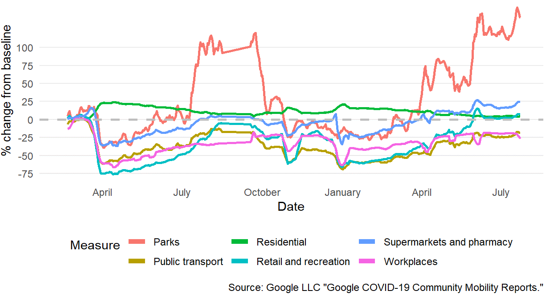
Adherence
The most recent IPSOS MORI data for the period 16 – 19 July for Wales reports that perceptions of threat posed to the country by coronavirus has risen from 41% to 53%. Those only leaving home for essential journeys remained stable at 25%, lowest since the survey began in March 2020.
The latest results from the Public Engagement Survey on Health and Wellbeing during Coronavirus Measures (5 – 14 July) reports 85% of people said they understand current restrictions in Wales ‘very well’ or ‘fairly well’ and 37% of people said they were following coronavirus restrictions ‘completely’, down from 43% (21 – 27 June). It should be noted that this is self-reported adherence and will be affected by individuals’ understanding of the rules and circumstances that apply to them.
Results from the Coronavirus (COVID-19) Infection Survey, 18 July to 24 July
The percentage of people testing positive has decreased in Scotland in the most recent week and has continued to increase in England, Wales and Northern Ireland, although the rate of increase seems to be slowing in England.
It is estimated that an average of 18,800 people in Wales had COVID-19 (95% credible interval: 12,700 to 26,000), equating to around 1 in 160 people or 0.62% of the community population (up from 0.47% last week). This compares to around 1 in 65 people in England, around 1 in 110 people in Scotland, and around 1 in 65 people in Northern Ireland.
Source: Office for National Statistics COVID-19 Infection Survey.
Positivity rates (%) across UK countries up to 24 July 2021
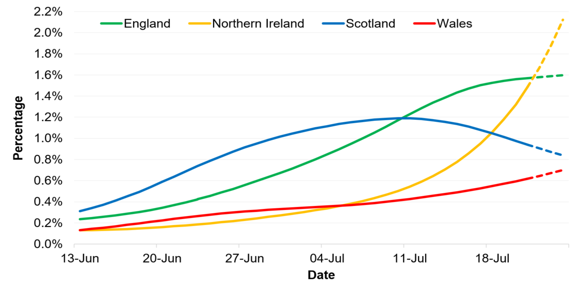
Vaccine and immunity status
Vaccination and antibody status of individuals aged 16 and over in Wales
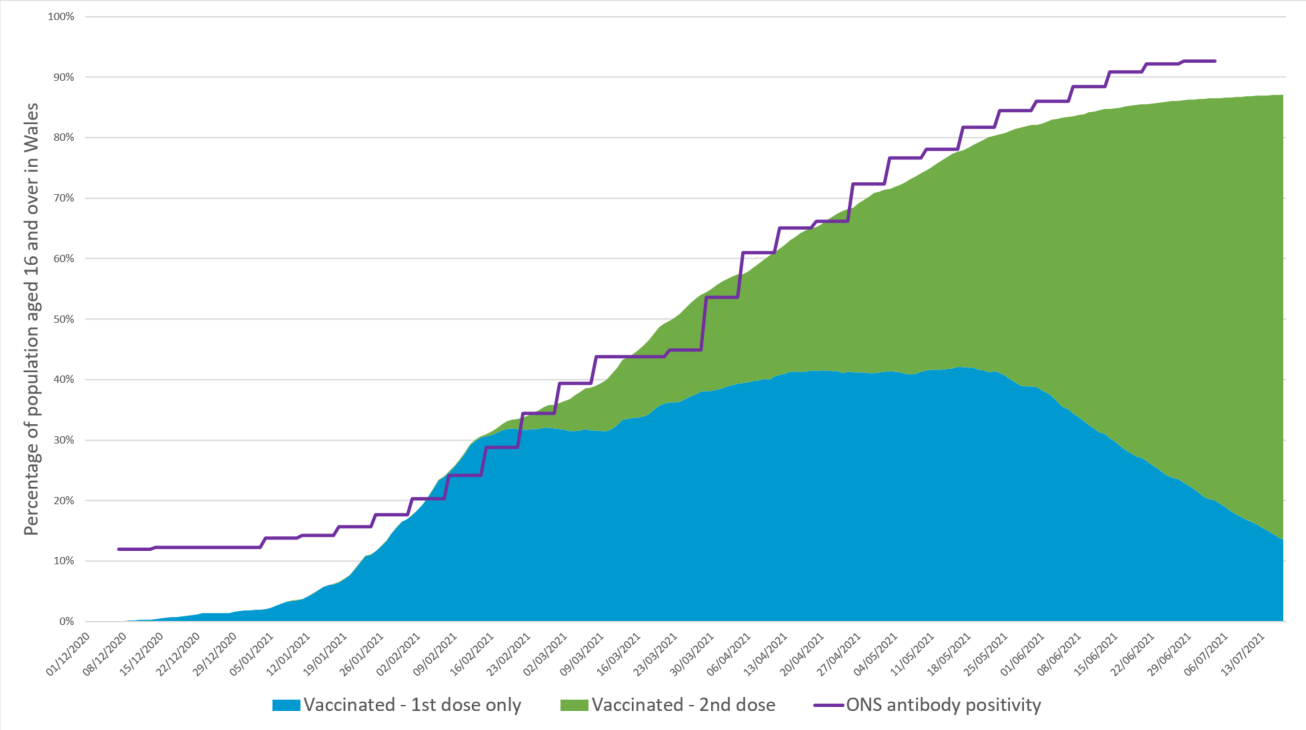
Immunity estimates and antibody status of individuals aged 16 and over in Wales
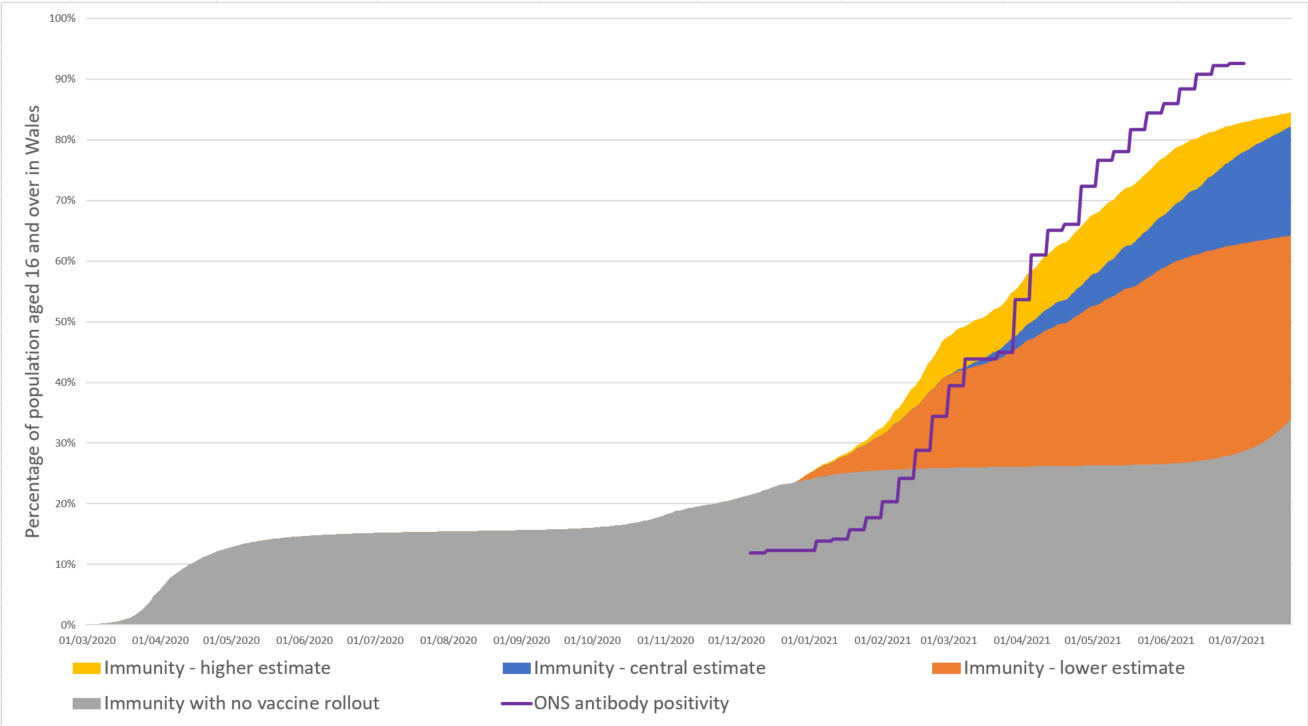
The COVID-19 vaccination rollout of first doses has slowed in Wales, but rollout of second doses continues to progress well. As at 24 July 2021, 87% of people aged 16 and over had received at least one COVID-19 vaccine dose in Wales. 11% of people aged 16 and over had exactly one vaccine dose and 76% were fully vaccinated.
Between 28 June and 4 July 2021, the ONS COVID-19 Infection Survey estimated that 92.6% of the community population aged 16 and over in Wales tested positive for COVID-19 antibodies.
As at 24 July 2021, it is estimated that 82% of people aged 16 and over in Wales had some immunity against COVID-19 infection. The lower and higher estimates of immunity are 64% and 85% of people aged 16 and over in Wales. If no vaccines had been administered, it is estimated that 34% of people aged 16 and over would be immune. These estimates assume 84% of natural infections lead to immunity, but do not account for waning immunity. [Source: SIREN study paper, The Lancet, published 9 April 2021]
It is currently estimated that over 80% (may be closer to 90%) of the population, spread evenly across Wales, must be immune to COVID-19 before population immunity effects would be observed. [Source: TAG advice on the Delta variant, published 18 June 2021] Note that the immunity estimate of 82% is for individuals aged 16 and over, not the total Wales population, and varies across age groups.
Differences between antibody presence and immunity estimates include:
- ONS antibody estimates are based on study participants who have volunteered for the study and estimates are extrapolated.
- ONS estimates are based on the 16+ community population, which excludes people in care homes or hospitals. Immunity estimates are based on the whole 16+ Wales population.
- While antibody protection doesn’t equal immunity from infection, it does give a useful indication of the level of protection from infection in the Welsh population.
- Antibody estimates use 2019 mid-year population estimates while we use 2020 estimates.
Source: ONS COVID-19 Infection Survey, PHW, SPI-M, Swansea University modelling
What does the situation look like going forward?
Based on the current rates observed with current restrictions:
Cases
The probability of incidence reaching greater than 200 per 100,000 between 8 August and 14 August is below 80% for all local authorities. The figure illustrates the probability (between 0 – 100%) of incidence being greater than 200 per 100,000. Source: Imperial College London
Probability of greater than 100 per 100,000 cases by local authority
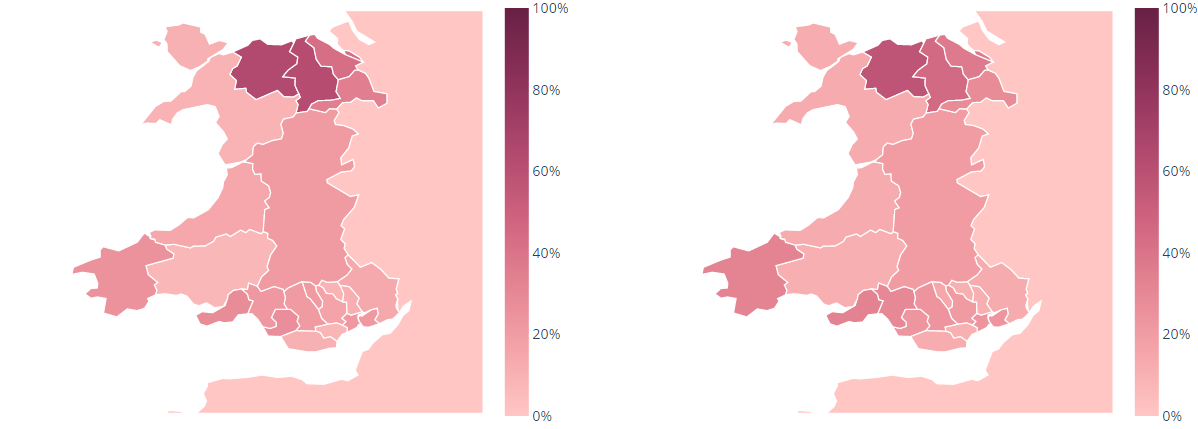
1 - 7 August and 8 - 14 August
Deaths per day
SPI-M's consensus view is that the number of deaths in Wales will remain low compared with previous waves over the next four weeks. Source: Modelled medium term projections, SAGE/SPI-M, 28 July
Hospitalisations per day
Projected to level off at around just over 20 per day over the next three weeks. Source: Modelled medium term projections, SAGE/SPI-M, 28 July
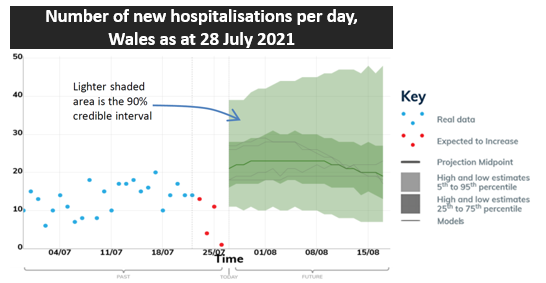
These projections are based on current trends and will not fully reflect the impact of policy or behavioural changes over the past two to three weeks. The projections include the impact of vaccines, but cannot capture any future increases in transmission resulting from new variants. They are not forecasts or predictions.
Key risks and sources
Key risks
Transmissions, incidence and prevalence
Overall transmission, percentage of people testing positive is slightly decreasing since last week.
Trends vary across health boards and local authorities.
NHS Capacity
COVID-19 pressure on the NHS has been steadily increasing over recent weeks. Invasive ventilated bed occupancy and hospital bed occupancy for COVID-19 related patients is increasing.
Mortality
Low numbers of deaths in the most recent week, although this is increasing.
Variants
Wales has 9,465 confirmed cases of the more transmissible Delta variant (an increase of 1,648 from the previous week). Delta remains the dominant variant of COVID-19 in Wales.
Immunity and vaccines
4.33 (+0.09) million doses of COVID-19 vaccine have been given in Wales, of which 2.29 (+0.01) million were first doses and 2.04 million (+0.08) were second doses. Around 82% of people aged 16 and over have some immunity in Wales.
International
There is an increase in traveller numbers this week, however positive rates are relatively low.
